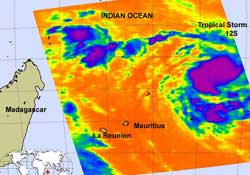NASA Sees Tropical Storm 12S as a Threat to Madagascar

The AIRS instrument on NASA's Aqua satellite captured this infrared image of Tropical Storm 12S on February 9, 2012 at 09:41 UTC (4:41 a.m. EST). The strongest thunderstorms and heaviest rainfall are close to the center of circulation and in bands of thunderstorms to the south of the center, (purple) where cloud top temperatures are below -63 F (-52.7C). Credit: NASA/JPL, Ed Olsen<br>
Forecasters at the Joint Typhoon Warning Center expect a landfall in Madagascar in several days.
The Atmospheric Infrared Sounder (AIRS) instrument on NASA's Aqua satellite captured an infrared image of Tropical Storm 12S on February 9, 2012 at 09:41 UTC (4:41 a.m. EST) south of Diego Garcia.
Forecasters at the Joint Typhoon Warning Center noted that the system has consolidated quickly with improved convective banding (of thunderstorms) wrapping into the center.
The strongest thunderstorms and heaviest rainfall are close to the well-defined center of circulation and in bands of thunderstorms to the south of the center, where cloud top temperatures are below -63 F (-52.7C).
On February 9 at 1500 UTC (10 a.m. EST), Tropical Storm 12S (TS12S) had maximum sustained winds near 35 knots (40 mph/~65 kph). It was located 690 nautical miles (794 miles/1,278 km) northeast of La Reunion Island near 14.1 South latitude and 65.1 East longitude.
It was moving to the west near 9 knots (10.3 mph/16.7 kph) toward Madagascar. The forecasters at the Joint Typhoon Warning Center expect TS12S to strengthen as it moves west because of warm sea surface temperatures and light wind shear. Landfall at cyclone strength is expected in east central Madagascar sometime on February 13.
Text Credit: Rob Gutro
NASA's Goddard Space Flight Center, Greenbelt, Md.
Media Contact
All latest news from the category: Earth Sciences
Earth Sciences (also referred to as Geosciences), which deals with basic issues surrounding our planet, plays a vital role in the area of energy and raw materials supply.
Earth Sciences comprises subjects such as geology, geography, geological informatics, paleontology, mineralogy, petrography, crystallography, geophysics, geodesy, glaciology, cartography, photogrammetry, meteorology and seismology, early-warning systems, earthquake research and polar research.
Newest articles

Solving the riddle of the sphingolipids in coronary artery disease
Weill Cornell Medicine investigators have uncovered a way to unleash in blood vessels the protective effects of a type of fat-related molecule known as a sphingolipid, suggesting a promising new…

Rocks with the oldest evidence yet of Earth’s magnetic field
The 3.7 billion-year-old rocks may extend the magnetic field’s age by 200 million years. Geologists at MIT and Oxford University have uncovered ancient rocks in Greenland that bear the oldest…

Decisive breakthrough for battery production
Storing and utilising energy with innovative sulphur-based cathodes. HU research team develops foundations for sustainable battery technology Electric vehicles and portable electronic devices such as laptops and mobile phones are…





















